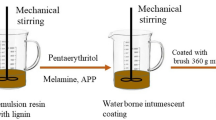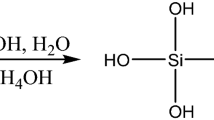Abstract
A mixture of etherified melamine–formaldehyde and acrylic emulsion resin was designed, with the hybrid resin improving the fire retardancy of indoor plywood as well as the CO and CO2 emissions. The water-based hybrid resin exhibited a single curing peak; the need for solvents was reduced. Compared with pure etherified melamine–formaldehyde resin, the hybrid resin had better flame retardancy and produced less pollution. Scanning electron microscopy and cone calorimetry were conducted, and the analyses revealed that lower binder resin concentrations resulted in improved flame retardancy and better char layer formation. When the binder resin concentrations were increased and CO/CO2 emissions were continued beyond 300 s, the flame retardancy of the intumescent coating was the same as that of the lower binding resin concentrations. Furthermore, the chemical structure and durability of the phosphocarbonaceous structure were verified through Fourier transform infrared spectroscopy and solid-state nuclear magnetic resonance analyses.









Similar content being viewed by others
Abbreviations
- AC:
-
Acrylic emulsion resin
- BR:
-
Binder resin
- CS:
-
Carbonizing substance
- FPS:
-
Foam producing substance
- DA:
-
Dehydrating agent
- FRMF :
-
Intumescent coating use etherified melamine formaldehyde resin as a binder resin
- MF:
-
Etherified melamine formaldehyde
- THR:
-
Total heat release
- Time to PHRR:
-
Time to peak heat release rate
References
Li, M, Bian, C, Yang, GX, Qiang, XH, “Facile Fabrication of Water-Based and Non-Fluorinated Superhydrophobic Sponge for Efficient Separation of Immiscible Oil/Water Mixture and Water-in-Oil Emulsion.” Chem. Eng. J., 368 350–358 (2019)
Sharifi, Z, Pakshir, M, Amini, A, Rafiei, R, “Hybrid Graphene Oxide Decoration and Water-Based Polymers for Mild Steel Surface Protection in Saline Environment.” J. Ind. Eng. Chem., 74 41–54 (2019)
Jiang, J, Li, J, Gao, Q, “Effect of Flame Retardant Treatment on Dimensional Stability and Thermal Degradation of Wood.” Construct. Build. Mater., 75 74–81 (2015)
Huang, Y, Jones, FN, “Synthesis of Crosslinkable Acrylic Latexes by Emulsion Polymerization in the Presence of Etherified Melamine-Formaldehyde (MF) Resins.” Prog. Org. Coat., 28 133–141 (1996)
Han, RL, Zhang, YF, “Studies on Performance of Cured Water-Borne Melamine–Acrylic Emulsion Coatings.” J. Adhes. Sci. Technol., 25 883–892 (2011)
Córdoba, CA, Collins, SE, Passeggi, MCG, Vaillard, SE, Gugliotta, LM, Minari, RJ, “Crosslinkable Acrylic-Melamine Latex Produced by Miniemulsion Polymerization.” Prog. Org. Coat., 118 82–90 (2018)
Córdoba, CA, Ronco, LI, Passeggi, MCG, Minari, RJ, Gugliotta, LM, “Waterborne Acrylic-Melamine Latexes with Controlled Film Microstructure.” Prog. Org. Coat., 136 105239 (2019)
Magami, SM, Guthrie, JT, “Amino Resin Cross-Linked Can Coatings.” Surf. Coat. Int., 95 64–73 (2012)
Paine, MRL, Pianegonda, NA, Huynh, TT, Manefield, M, MacLaughlin, SA, Rice, SA, Barker, PJ, Blanksby, SJ, “Evaluation of Hindered Amine Light Stabilisers and Their N-Chlorinated Derivatives as Antibacterial and Antifungal Additives for Thermoset Surface Coatings.” Prog. Org. Coat., 99 330–336 (2016)
Li, ZS, Wang, HJ, Zhang, S, Zhao, W, Jiang, QH, Wang, MQ, Zhao, J, Lu, W, “Smoke Density Evaluation of Acrylic Resin and Intumescent Flame Retardant Coatings.” Pigm. Resin Technol., 45 86–92 (2016)
Dong, X, Yang, JN, Hua, XZ, Nie, SB, Kong, FB, “Synthesis of a Novel Char-Forming Agent (PEIC): Improvement in Flame Retardancy, Thermal Stability, and Smoke Suppression for Intumescent Flame-Retardant Polypropylene Composites.” J. Appl. Polym. Sci., 137 48296 (2020)
Yew, MC, Sulong, NR, “Fire-Resistive Performance of Intumescent Flame-Retardant Coatings for Steel.” Mater. Des., 34 719–724 (2012)
Jaramillo, AF, Díaz-Gómez, A, Ramirez, J, Berrio, M, Cornejo, V, Rojas, D, Montoya, L, Mera, A, Melendrez, M, “Eco-Friendly Fire-Resistant Coatings Containing Dihydrogen Ammonium Phosphate Microcapsules and Tannins.” Coatings, 11 280 (2021)
Liang, SY, Neisius, NM, Gaan, S, “Recent Developments in Flame Retardant Polymeric Coatings.” Prog. Org. Coat., 76 1642–1665 (2013)
Yew, MC, Sulong, NHR, Yew, MK, Amalina, MA, Johan, MR, “Influences of Flame-Retardant Fillers on Fire Protection and Mechanical Properties of Intumescent Coatings.” Prog. Org. Coat., 78 59–66 (2015)
Chuang, CS, Tsai, KC, Wang, MK, Ou, CC, Ko, CH, Shiau, IL, “Effects of Intumescent Formulation for Acrylic-Based Coating on Flame-Retardancy of Painted Red Lauan (Parashorea spp.) Thin Plywood.” Wood Sci. Technol., 42 593–607 (2008)
Alongi, J, Han, ZD, Bourbigot, S, “Intumescence: Tradition Versus Novelty. A Comprehensive Review.” Prog. Polym. Sci., 51 28–73 (2015)
Pimenta, JT, Concalves, C, Hiliou, L, Coelho, JFJ, Magalhars, FD, “Effect of Binder on Performance of Intumescent Coatings.” J. Coat. Technol. Res., 13 227–238 (2016)
Puri, RG, Khanna, AS, “Intumescent Coatings: A Review on Recent Progress.” J. Coat. Technol. Res., 14 1–20 (2017)
Anees, SM, Dasari, A, “A Review on the Environmental Durability of Intumescent Coatings for Steels.” J. Mater. Sci., 53 124–145 (2018)
Duquesne, S, Magnet, S, Jana, C, Delobel, R, “Thermoplastic Resins for Thin Film Intumescent Coatings - Towards a Better Understanding of Their Effect on Intumescence Efficiency.” Polym. Degrad. Stab., 88 63–69 (2005)
Samyn, F, Bourbigot, S, “Thermal Decomposition of Flame Retarded Formulations PA6/Aluminum Phosphinate/Melamine Polyphosphate/Organomodified Clay: Interactions Between the Constituents?” Polym. Degrad. Stab., 97 2217–2230 (2012)
Girardin, B, Fontaine, G, Duquesne, S, Forsth, M, Bourbigot, S, “Measurement of Kinetics and Thermodynamics of the Thermal Degradation for Flame Retarded Materials: Application to EVA/ATH/NC.” J. Anal. Appl. Pyrol., 124 130–148 (2017)
Chuang, CS, Fan, YJ, Sheen, HJ, “Flame Retardancy Effects on Intumescent Coatings with Vinyl Acetate Copolymers.” Int. Polym. Process., 34 541–550 (2019)
Chuang, CS, Wu, CY, Wu, KC, Sheen, HJ, “Flame Retardancy of Water-Based Intumescent Coatings with Etherified Melamine-Formaldehyde and Polyvinyl Acetate Copolymer Hybrid Resin.” J. Appl. Polym. Sci., 137 e49279 (2020)
Pizzi, A, Panamgama, LA, “Diffusion Hindrance vs. Wood-Induced Catalytic Activation of MUF Adhesive Polycondensation.” J. Appl. Polym. Sci., 58 109–115 (1995)
Chiu, HT, Huang, YC, Chiang, CH, “Curing Behavior of Anionic Poly(urethane urea) Dispersions Crosslinked with Partially Methylated Melamine Formaldehyde.” J. Appl. Polym. Sci., 106 849–856 (2007)
Merline, DJ, Vukusic, S, Abdala, AA, “Melamine Formaldehyde: Curing Studies and Reaction Mechanism.” Polym. J., 45 413–419 (2013)
Farag, ZR, Friedrich, JF, Kruger, S, “Cured Melamine Systems as Thick Fire-Retardant Layers Deposited by Combination of Plasma Technology and Dip-Coating.” J. Adhes. Sci. Technol., 29 807–820 (2015)
Xie, Y, Xu, J, Militz, H, Wang, F, Wang, Q, Mai, C, Xiao, Z, “Thermo-Oxidative Decomposition and Combustion Behavior of Scots Pine (Pinus sylvestris L.) Sapwood Modified with Phenol- and Melamine-Formaldehyde Resins.” Wood Sci. Technol., 50 1125–1143 (2016)
Xiao, Z, Liu, S, Zhang, Z, Mai, C, Xie, Y, Wang, Q, “Fire Retardancy of an Aqueous, Intumescent, and Translucent Wood Varnish Based on Guanylurea Phosphate and Melamine-Urea-Formaldehyde Resin.” Prog. Org. Coat., 121 64–72 (2018)
Lu, H, Zheng, SX, “Miscibility and Phase Behavior in Thermosetting Blends of Polybenzoxazine and Poly(ethylene oxide).” Polymer, 44 4689–4698 (2003)
Kim, S, Kim, HJ, “Study of Miscibility of Melamine-Formaldehyde Resin and Poly(vinyl acetate) Blends for use as Adhesives in Engineered Flooring.” J. Adhes. Sci. Technol., 20 209–219 (2006)
Camino, G, Costa, L, Martinasso, G, “Intumescent Fire-Retardant Systems.” Polym. Degrad. Stab., 23 359–376 (1989)
Lotsch, BV, Schnick, W, “New Light on an Old Story: Formation of Melam During Thermal Condensation of Melamine.” Chem. Eur. J., 13 4956–4968 (2007)
Dasari, A, Yu, ZZ, Cai, GP, Mai, YW, “Recent Developments in the Fire Retardancy of Polymeric Materials.” Prog. Polym. Sci., 38 1357–1387 (2013)
Liu, X, Hao, JW, Gaan, S, “Recent Studies on the Decomposition and Strategies of Smoke and Toxicity Suppression for Polyurethane Based Materials.” RSC Adv., 6 74742–74756 (2016)
Le Bras, M, Bourbigot, S, Revel, B, “Comprehensive Study of the Degradation of an Intumescent EVA-based Material During Combustion.” J. Mater. Sci., 34 5777–5782 (1999)
Bourbigot, S, Le Bras, M, Dabrowski, F, Gilman, JW, Kashiwagi, T, “PA-6 Clay Nanocomposite Hybrid as Char Forming Agent in Intumescent Formulations.” Fire Mater., 24 201–208 (2000)
Bourbigot, S, Le Bras, M, Delobel, R, Decressaing, R, Amourex, JP, “Synergistic Effect of Zeolite in an Intumescence Process: Study of the Carbonaceous Structures using Solid-State NMR.” J. Chem. Soc. Faraday Trans., 92 149–158 (1996)
Duncan, TM, Douglass, DC, “On the 31P Chemical Shift Anisotropy in Condensed Phosphates.” Chem. Phys., 87 339–349 (1984)
Acknowledgments
Financial support (MOST 111-2313-B-150-001, 108-2811-E-002-542 and 108-2221-E-002-052) from Ministry of Science and Technology of Taiwan is acknowledged. The authors would like to thank Ms. Su-Yun Fang (Instrument Center, NTHU) for Bruker AVANCE III-400 MHz Solid NMR analysis.
Author information
Authors and Affiliations
Corresponding author
Ethics declarations
Conflict of interest
The authors declare that there is no conflict of interest associated with this article.
Additional information
Publisher's Note
Springer Nature remains neutral with regard to jurisdictional claims in published maps and institutional affiliations.
Supplementary Information
Below is the link to the electronic supplementary material.
Rights and permissions
Springer Nature or its licensor (e.g. a society or other partner) holds exclusive rights to this article under a publishing agreement with the author(s) or other rightsholder(s); author self-archiving of the accepted manuscript version of this article is solely governed by the terms of such publishing agreement and applicable law.
About this article
Cite this article
Chuang, CS., Lin, PH. Thermal properties of intumescent coating with waterborne melamine-acrylic emulsion resin for plywood. J Coat Technol Res 20, 1193–1205 (2023). https://doi.org/10.1007/s11998-022-00736-5
Received:
Revised:
Accepted:
Published:
Issue Date:
DOI: https://doi.org/10.1007/s11998-022-00736-5




